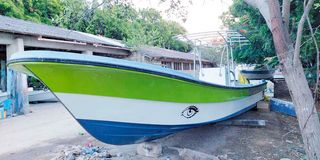Meet the self-taught boatmakers of Kipini, in Tana River County

One of the boats made by the Kipini Artisan Brothers.
Kipini, a tiny village where River Tana meets the Indian Ocean in Tana River County, is known for having 79 Kilometres of coastline.
In this quiet village, a group of self-taught artisans have been making a living through constructing boats for nearly a decade now.
The venture started with one of them learning the trade from skilled Italian artisans in Malindi, and satisfied that he had amassed the required skills to go it alone, resigned from his job and returned, home where he passed on his skills to others.
And so the Kipini Artisan Brothers group, composed of 12 members, was formed.
“During employment, I was not doing much as my employers tasked me with grinding the finished product and coating it, but I would observe other procedures keenly, something I did for a year before they expanded my duties,” recounts Omar Abdallah, the artisan.
It is while here that it occurred to him that he could earn a living through his skills, not only this, but also produce boats that cost much less than what was in the market. Abdallah had, however, not mastered the boat making process well, and so turned to tutorials on YouTube to refine his skills before training other interested artisans.
“We had a big challenge starting, we needed a lot of material to make the fiber, therefore we had to raise lots of money to achieve this,” he says.
For six months, all they did was fix broken boats as they gathered the money required to buy the material they needed to make a sample boat.

The power of teamwork. The group’s founder, Omar Abdallah, learnt the trade from Italian artisans based in Malindi, a skill that he has passed on to his fellow artisans.
After a long struggle and long wait, having saved for a year, in 2013, they were ready to start building their first boat.
“It requires a lot more than the fiber to build a boat. We spent about Sh200, 000 on the materials to build our first one – what we needed was not as expensive as it is today,” says Abdallah.
Once complete, their boats cost Sh300, 000, half the cost the same boat goes for in one of the popular boat shops at the Coast.
The process begins by smearing grease on an inverted boat structure or frame, which is then covered with waste newspapers in preparation for fiberglass application.
Thereafter follows the application of resin and hardener, and a thick fiber cloth soaked with resin and hardener.
“The fiberglass, resin, and hardener solution followed by the thick fiber cloth is repeatedly applied until we have about four to five layers. This is done to achieve the thickness of the vessel we have in mind,” he explains.
The artisans later apply a seal coat, which serves to block seeping of water into the boat and also to inhibit blister formation in underwater gel coats and fiberglass.
The fiberglass cloth on the resin coating goes next, followed by the bond coat to wet the surface for glassing, to bond fiberglass, and to fill the fiberglass weave.
“We do the fill coat to fill in the weave texture of the fiberglass so that it can be sanded smooth. It has to be thick, otherwise the boat will wear and tear after just two trips in the sea,” he explains.
A final resin coat is then applied and then the team moves to coat the boat with paint.
It is a procedure that can take a week to finish, after which the client gets their boat.
Mwanahamisi Salim, the group’s accounting officer, says that the team makes a profit of at least Sh70, 000 from one boat after deducting all working costs. They make at least six boats every season.
“We do not have many clients like our colleagues in Malindi and Lamu, who make up to 10 boats every season, we are still very young in the business, but will grow with time - there is a huge potential in this,” she says.
Thirty percent of their earnings go to their savings in a Sacco, while 20 percent of it goes back to the business. Another 25 percent is divided among the three founders, while the remaining 25 percent is shared among the rest of the team.
The members are at liberty to borrow loans as long as they contribute five percent of their earnings to the Sacco they are in partnership with.
The group faces several challenges in their art, as most of the material comes from Nairobi where it is cheaper compared to other places.
Lack of a proper yard for work and proper gear is also another challenge they face.

A boat made by the Kipini Boat Makers at their yard in Tana River County.
“We still look forward to making this a big industry in our region. If we are supported to expand this idea, we will be able to hire more than 200 youth, and with good market support, the region will not have to import such vessels,” comments Mwanahamisi.
Engineer Julius Diribo, a vessel expert, says the boats and dhows are good and safe enough to go five nautical miles to fish though there is a lot that still needs to be done regarding the safety in the sea in case of high tides.
“Their vessels are strong, no doubt, and with a few added elements, have potential to be the best for any market,” he says.
For instance, the boat should incorporate personal floating devices, a horn or bell and also connect flood light gadgets. Diribo also advises incorporating a Visual Distress Signal incase fishermen experience breakdown at sea.
Buoyed by their achievement so far, the group foresees a brighter future for their business, as they source for financial support to upscale their production and sharpen their skills.





